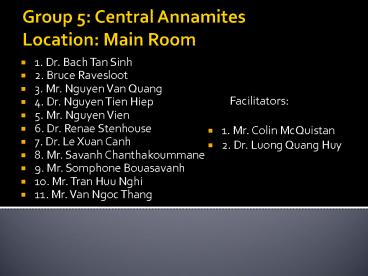Group 5: Central Annamites Location: Main Room - PowerPoint PPT Presentation
Title:
Group 5: Central Annamites Location: Main Room
Description:
Rock rats. Khanou. Endemic fish species. Gaur. Neusnakes ... Rubber/Acacia/Eucalyptus plantations. Hydropower plants. Population growth / Migration / Swidden ... – PowerPoint PPT presentation
Number of Views:47
Avg rating:3.0/5.0
Title: Group 5: Central Annamites Location: Main Room
1
Group 5 Central AnnamitesLocation Main Room
- 1. Dr. Bach Tan Sinh
- 2. Bruce Ravesloot
- 3. Mr. Nguyen Van Quang
- 4. Dr. Nguyen Tien Hiep
- 5. Mr. Nguyen Vien
- 6. Dr. Renae Stenhouse
- 7. Dr. Le Xuan Canh
- 8. Mr. Savanh Chanthakoummane
- 9. Mr. Somphone Bouasavanh
- 10. Mr. Tran Huu Nghi
- 11. Mr. Van Ngoc Thang
- Facilitators
- 1. Mr. Colin McQuistan
- 2. Dr. Luong Quang Huy
2
Central Annamites
3
Habitat
- Limestone forest / Karst
- Evergreen forest
- Everwet Pl. Refogia
- Broadleaf mixed conifer
- Lagoon
- River basin
4
Species
5
Ecosystem services
- Electricity potential Hydropower
- Water supply irrigation / urban
- Groundwater conservation
- EcoTourism
- Carbon storage
- Livelihoods safety net forest/wetland resources
- NTFPs (medicinal, ornamental)
- Cultural / Spiritual Services
- Erosion / landslide / flood control
- Soil conservation
- Micro-climate regulation (rainfall, temp.)
6
Developments
7
Impacts priority order
- Impacts ranked according to (i) Severity (ii)
Reversibility (iii) Scale - Severity scale of impacts to biodiversity value
- Extinction / biodiversity loss
- Habitat loss
- Wildlife / timber trade
- Degradation of waterways (including erosion,
sediment, etc.) - Relocation / settlement / population growth
(including loss of traditional knowledge
8
Other impacts
- Fishery (negative at downstream, positive at
reservoirs) - Payment for Environmental Services
- Pollutions (air, water, soil)
- Pressure on traditional livelihoods
- Increased accessibility to economically valuable
species - Land price fluctuation
- Ecotourism development / opportunity
- Protected areas planning
- Chemical contamination
- Infrastructure development
- Increase subsistence logging and hunting
- Invasive species
- Loss of natural restoration areas
9
Sensitivity / Vulnerability
- Habitat
- Summit conifer forest
- Steep slopes
- Coastal lagoons
- Wetlands
- Species
- Montane birds
- Turtle and terappins
- Ecosystem services
- Hydropower potential
- Water supply (agriculture, urban)
- Wetland resources
- Forest (uncertain)
- Erosion control / Soil conservation
10
Unknown / Uncertainty / Gaps
- Little understanding of
- The Annamites ecology
- Inherent species plasticity
- Species migration as temp and rainfall changes
- Seasonal changes of temp and rainfall
- Seasonal humidity changes
- If less wet months, everwet forest being
vulnerable
11
Impacts and Adapation
- Central Annamites
12
Climate change impacts on developments
- Prioritised
- Erosion / Landslides / Degradation of
infrastructure - Forest Fire
- Plantations expansion / shifts
- More water storage scheme
- Agriculture productivity changes
- Other relevant concerns
- Flood
- Pollutions
- Sedimentation
- Changes of National Strategies
- Increase of Protected Areas
13
Combined impacts on biodiversity / NR
Climate Change Impacts
Developments
Drought
Storm events
Water storage
Logging
Farming
Roads
Fire
Flood
Habitat loss Biodiversity reduction Changes in
aquatic ecology
Soil erosion Slope instability Sedimentation
14
Adaptation options
- Priority
- Protected areas enhancement (i) Terrestrial (ii)
Wetlands and (iii) Lagoons - Smart Infrastructure Planning
- Integrated Water Resources Management
- Landscape restoration / reforestation
- Climate-tolerant agriculture (community-based)
- Effective use of local knowledge
- Additional
- REDD and REDD
- Biodiversity planning
- Improvement of Forest Fire Control System
(community-based) - Invasive species control
- NTFP-based livelihoods development
15
Capacity / Institutional Needs (1)
- Protected Areas Management
- Capacity building and strengthen human resources
- PA Unit in the Division of Forestry and Resource
Conservation (DFRC) in Laos to be upgraded to
Department level - Funding to be diversified (Gov. NGOs, Private
sectors) to setup new PAs and meet the need of
current Pas - Improvement of Law Enforcement
- Landscape restoration
- Infrastructure Planners consider restoration
- Awareness raising for planners
- Joint monitoring for REDD, Invasive species,
Forest Fire, Transboundary Trade and Climate
Change indicator species
16
Capacity / Institutional Needs (2)
- Awareness raising
- Community and authority at district / community
level, - Participatory planning
- Facilitate adaptive planning
- Research
- Address uncertainties
- Improve understanding / interpretation between
Scientist and Policy Makers - IWRM Capacity, concepts, institutional
cooperation - Transboundary collaboration and cooperation































